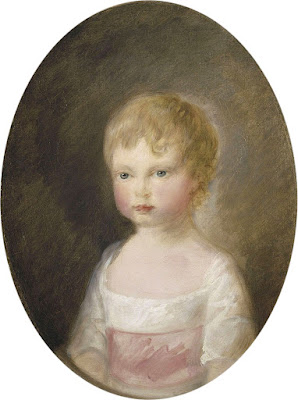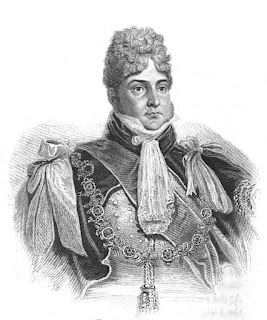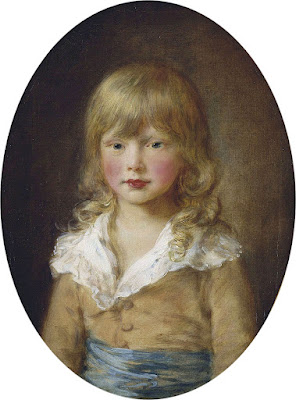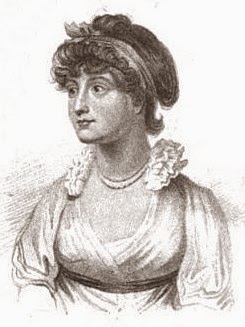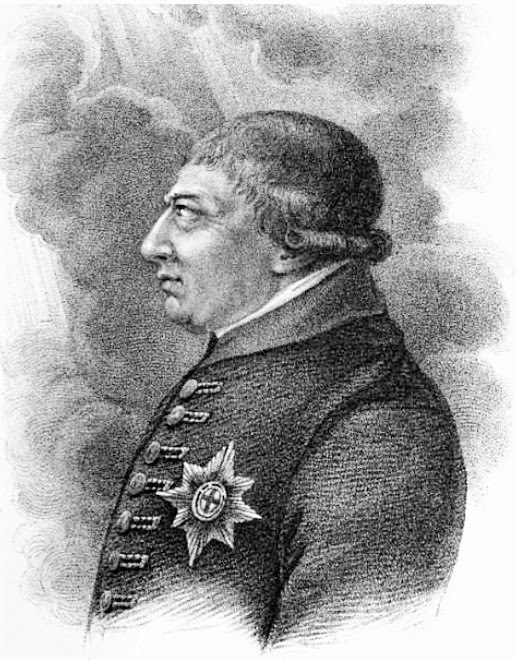 |
Carlton Palace
from Memoirs of George IV by Robert Huish (1831) |
A celebration of the Regency
On 19 June 1811,
the Prince Regent held a magnificent fête at
Carlton House. Ostensibly, it was held in honour of the King’s birthday and to show support for the exiled French royalty; in reality it was a celebration of the Regency period. George had wanted to revel in his advent to power ever since he had become Regent but he had feared that his father might recover and the party had twice been put off.
Notable absentees
More than two thousand invitations were sent out for the most prestigious event of the year. Those fortunate enough to be invited started arriving well before the stated time of nine o’clock. By eight, Pall Mall, St James’ Street and the Haymarket were all blocked with carriages.
But not everyone accepted.
The Queen refused to be present, angry with her son for holding a party when his father was so ill, and she would not let her daughters go. Much to her disappointment,
Princess Charlotte was not allowed to attend and was sent to Windsor to stay with her grandmother.
 |
Mrs Fitzherbert
from Memoirs of George IV
by Robert Huish (1831) |
A notable absentee was
Mrs Fitzherbert. Her relationship with the Regent was by this time very strained, owing to the ascendancy of
Lady Hertford. When she discovered that Lady Hertford had been granted a seat at the Prince’s table and she had not, she refused to attend.
 |
Marchioness of Hertford
from Ladies' Monthly Museum (1816) |
Princess Caroline, George’s estranged wife, was, unsurprisingly, not invited, but
the Duchess of York was there, wearing a patent net dress richly embroidered in silver and covered in diamonds.
A royal reception
The Regent sat in the Council Chamber under a crimson canopy to receive the French royal family: the Comte de Lisle, the Duc de Bourbon, the Duc de Berri, the Prince of Condé and the Duchess of Angouleme.
La Belle Assemblée described the Regent's appearance:
The Regent wore a Field Marshal’s uniform (as did the Duke of York), with his hair in a queue, the cordon blue, and a superb brilliant star, a diamond loop and button in his hat and feather.1
He was 48 years of age, but years of dissipated living had taken their toll and he looked older.
The “Palace of Enchantment”
Carlton House was decorated elaborately for the entertainment. The conservatory
...presented, at one glance, the fine effect of a lofty aisle in an ancient cathedral. Between the pillars, candelabras were suspended twelve feet above the ground, each presented four brilliant patent burners, which spread a breadth of light not easy to describe. The interior struck the beholder with astonishment. The grand table extended the whole length of the Conservatory, and across Carlton House, to the length of two hundred feet.2
The ballroom
The Grand Council Chamber was set aside for dancing which began around 12 o’clock with a dance called the “Miss Johnstone” led by Earl Percy and Lady Jane Montague. The ballroom floor was chalked in elaborate arabesque designs, with the initials of the King in the centre.
Around the edge of the ballroom, a number of “conversation stools” were placed for those who chose to watch rather than dance. The huge number of guests and the heat of the evening made the demand for these intense.
The Regent’s table
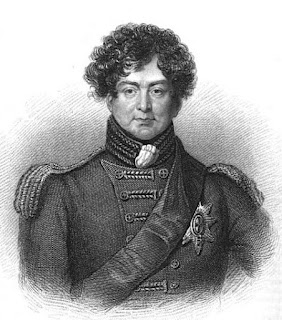 |
George IV
from La Belle Assemblée (1830) |
Supper was served around three o’clock. The Prince Regent sat at the head of the state table at which 200 favoured guests were seated. Behind him, stands were draped with crimson silk and piled with silver plate. From this position, the Regent was able to see, and be seen by, everyone.
An astonishing table decoration
La Belle Assemblée described the Prince’s table:
Along the centre of the table, about six inches above the surface, a canal of pure water continued flowing from a silver fountain, beautifully constructed at the head of the table. Its faintly waving, artificial banks were covered with green moss and aquatic flowers; gold and silver-coloured fish, were, by a mechanical invention, made to swim and sport through the bubbling current, which produced a pleasing murmur, where it fell, and formed a cascade at the outlet.3
Supper fit for a Prince
One of the guests described the supper:
Tureens, dishes, plates, even soup plates, were everywhere of silver with as many changes as were wanted. There were hot soups and roasts, all besides cold, but of excellent and fresh cookery. Peaches, grapes, pine apples, and every other minor fruit in and out of season were in profusion. Iced champagne at every three or four persons, all the other wines also excellent. There was no crowding, hurry or bustle in waiting; everything was done as in a private house.4
There were sixty attendants, dressed in blue liveries trimmed with gold lace, and reportedly one “in a complete suit of ancient armour.”5
The gardens
Outside, covered walks had been specially constructed to act as promenades and supper galleries. The aisle opposite the Conservatory was furnished with large looking glasses, girandoles (ornamental branched candlesticks) and candelabras, and the walkways were decorated with garlands of flowers. The guests were entertained by music from the bands playing in the four marquees erected on the lawn and by a brilliant fireworks display.
Public opinion
According to Thomas Moore, the whole entertainment was “worthy of a Prince.” Another guest was equally impressed:
The extraordinary part of it was that so large a number should have been served in such a style.6
But the fête gave plenty of fuel to the Regent’s critics.
What think you of the bubbling brooks and mossy banks at Carlton House? asked Shelley. It is said that this entertainment will cost £120,000. Nor will it be the last bauble which the nation must buy to amuse this overgrown bantling of Regency.7
Rachel Knowles writes clean/Christian Regency era romance and historical non-fiction. She has been sharing her research on this blog since 2011. Rachel lives in the beautiful Georgian seaside town of Weymouth, Dorset, on the south coast of England, with her husband, Andrew.
Find out more about Rachel's books and sign up for her newsletter here.
If you have enjoyed this blog and want to encourage me and help me to keep making my research freely available, please buy me a virtual cup of coffee by clicking the button below.
Notes
- La Belle Assemblée (June 1811).
- Ibid.
- Ibid.
- Hibbert, Christopher, George IV (1973).
- Ibid.
- Ibid.
- Ibid.
Sources used include:
Bell, John, La Belle Assemblée (Various, London)
Hibbert, Christopher, George IV (Longmans,1972, Allen Lane, 1973, London)
Huish, Robert, Memoirs of George IV (Thomas Kelly, 1830, 1831, London)
Stuart, Dorothy Margaret, Regency Roundabout (Macmillan & Co. Ltd, 1943, London)
Photographs © RegencyHistory.net
